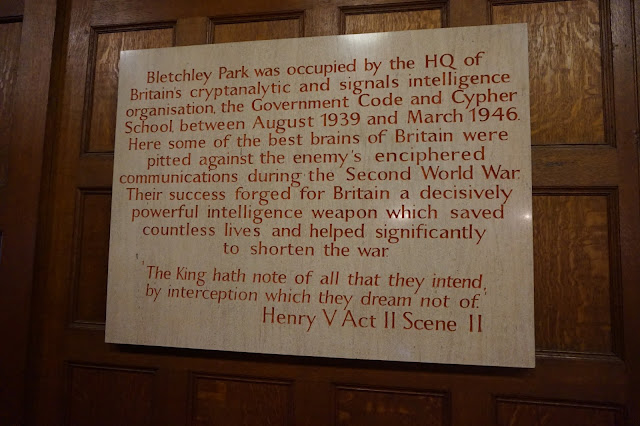 |
| Bletchley Park "Mansion" from across the pond |
 |
| A bit of the grounds at Bletchley Park |
 |
| The Mansion |
I found both the exterior and the interior to be absolutely exquisite! Though it has been called by some a "maudlin and mounstrous pile" because it combines Victorian Gothic, Tudor and Dutch Baroque styles. Though construction on this mansion didn't begin until 1878, residence on this site goes back at least as far as the Domesday Book of 1086, when it was part of the Manor of Eaton.
It's hard to estimate the full value of the work that was done here. Until fairly recently it was Britain's "best kept secret." Secrecy surrounding the activity done here was vital to national security and to victory in WWII. As the plaque below expresses the intelligence work done here saved countless lives and helped significantly shorten the war.

One benefit of this location is that it includes extensive grounds that could be used for recreation from their intense work by the mathematicians and other intelligence workers and staff that were housed here. The pond, seen in the first image in this post, would freeze over in winter and be used for ice-skating. There are also tennis courts on the grounds.
Below is a view of the cottages where Turing and others made breakthroughs on the German Enigma Code. Also included are photographs of some informational signage from this area.
 |
The Cottages, Bletchley Park |
Turing, a fellow of Trinity College, Cambridge, was instrumental in developing The Bombe which functioned to discover daily settings of the German Enigma machines. Among other influences he was inspired in his work in logic and computing by the work of Charles Babbage and Ada Byron Lovelace (whose powerful story I have blogged about here). Pictured below is a replica of The Bombe, which is on display in The Mansion. It is a prop from the 2014 movie about these events and this era "The Imitation Game," starring Benedict Cumberbatch.
As well as the mansion and the cottages, which already existed on the site when M16 bought the estate, many huts were built to house specific aspects of the intelligence work going on at B.P. (as it was affectionately known by those who worked there). For instance, Hut 4 dealt with Naval Intelligence, Hut 7 dealt with the Cryptanalysis of Japanese Naval Codes, Hut 2 was for "beer, tea, and relaxation," and Hut 11 was for Bombe Building.
Alan Turing was a brilliant mathematician who contributed much to mathematics, to the foundations of computer science, and to the war effort. He is widely acknowledged as the Father of Modern Computing and also as the Father of Artificial Intelligence. His "Turing Machine"can be considered a model of a general purpose computer. In 1951 he was elected a member of the Royal Society of London. Yet for all that he contributed, because of the secrecy of the war effort his contributions could not be recognized in his time. Additionally, his life ended tragically.
In 1952 Turing, who was homosexual, met a young man with whom he began a relationship. An acquaintance of his partner robbed Turing's house. Turing reported the robbery to the police, and during questioning it came out that he was in a homosexual relationship. At that time homosexual acts were considered criminal offences in England, and Turing was charged with "gross indecency." He plead guilty and was given a choice between imprisonment or probation which would include hormonal treatments with estrogen to suppress his libido. The conviction also led to the loss of his security clearance, and it barred him from further cryptographic consulting for the British government. He was also denied entry into the United States after this conviction.
Two years after his conviction his housekeeper found him dead in his home. He had died of potassium cyanide poisoning. There is some doubt as to whether his death was accidental or if it was suicide. He was working with electrolysis experiments at the time and may have accidentally ingested it. His mother maintained that his death was accidental. But a half eaten apple was found by his bedside when his body was discovered, and, according to his biographer David Leavitt, his favorite fairy tale was Snow White and the Seven Dwarfs, and, in Leavitt's words, Turing took "an especially keen pleasure in the scene where the Wicked Queen immerses her apple in the poisonous brew."
Mathematician and artist Lidia Luquet, captured this tragedy well in her painting, pictured below, a Magritte homage which brought me to tears when I saw it displayed at a conference at U.C. Davis early in my sabbatical semester (more about that at this link).
 |
| One last look at The Mansion |
There are a number of excellent movies about the life of Alan Turing and/or the work at Bletchley Park. One of these is the 2014 film The Imitation Game starring Benedict Cumberbatch, another is the 2001 film Enigma starring Dougray Scott and Kate Winslet, and my favorite is the 1996 BBC production Breaking the Code: Biography of Alan Turing starring Derek Jacobi (which can be found at this link on youtube).
















No comments:
Post a Comment